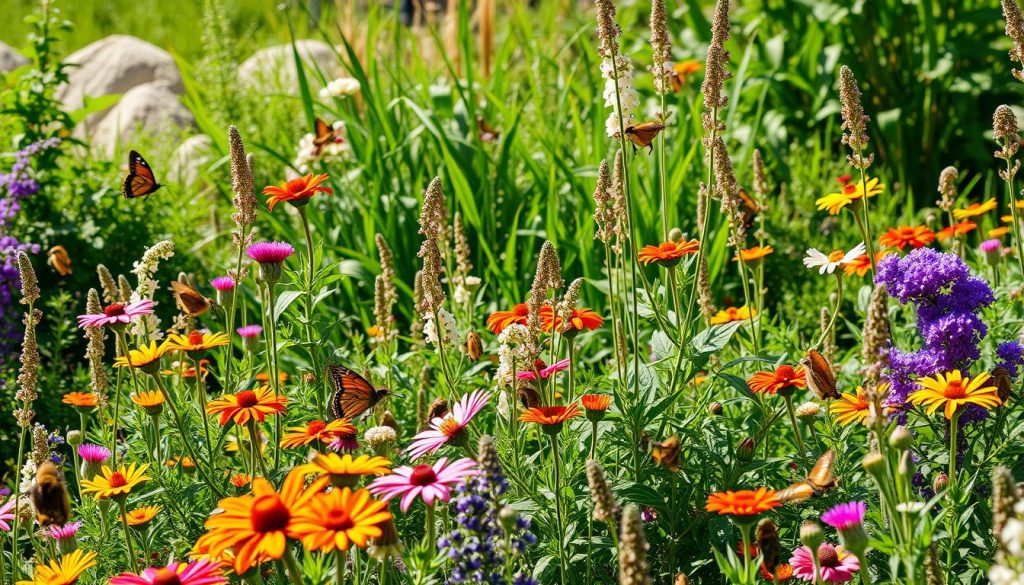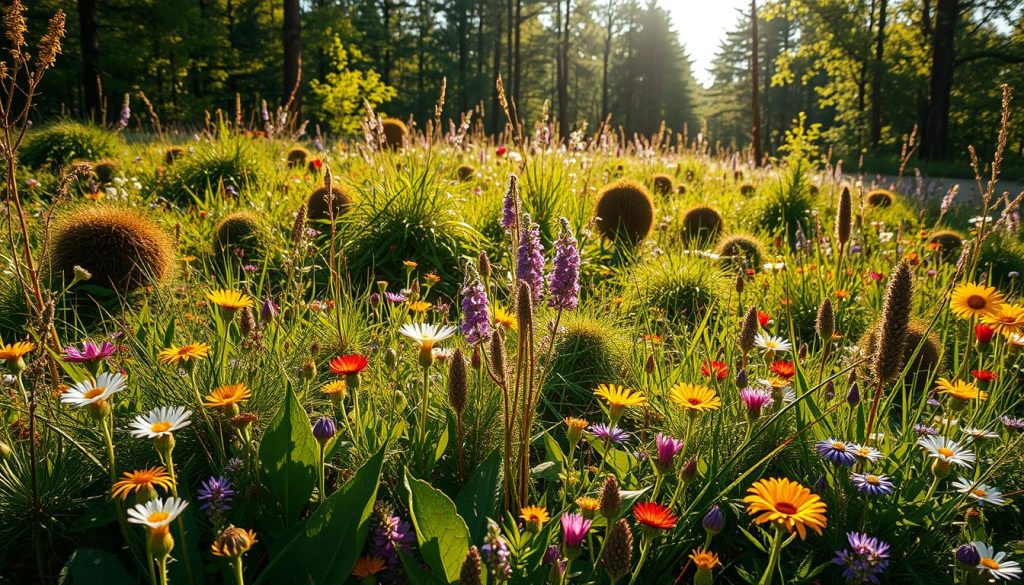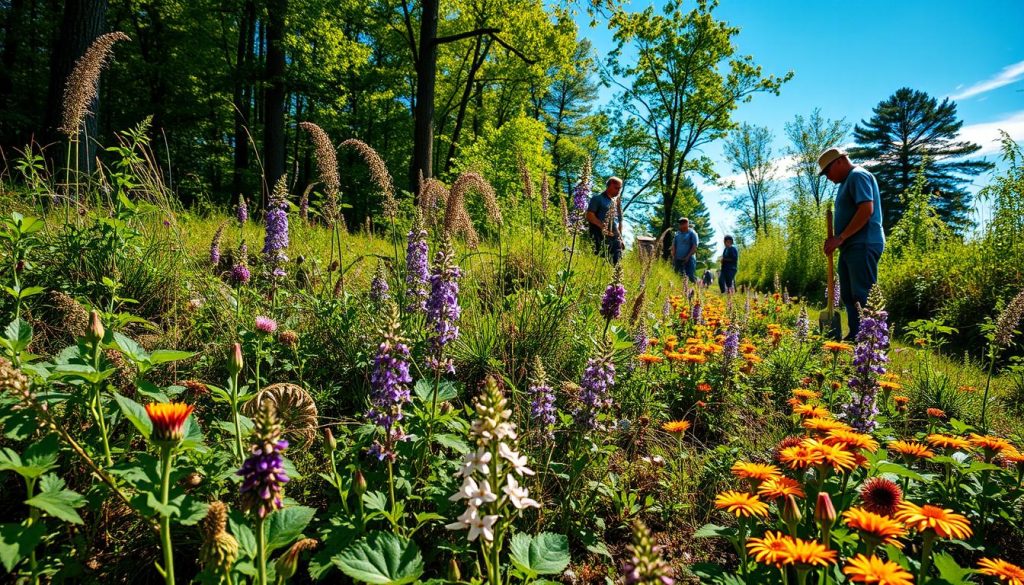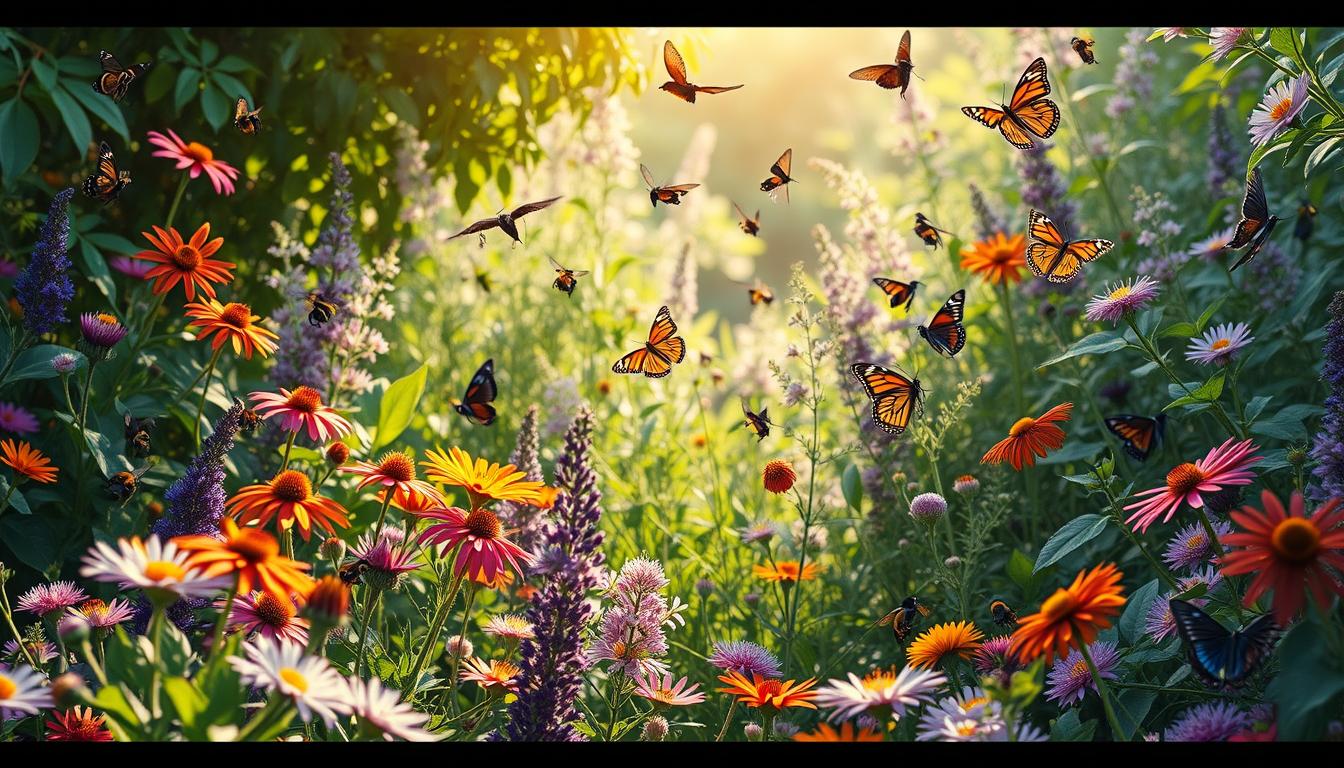I’m excited to share my passion for native plants and biodiversity. These plants are the unsung heroes of our natural world. They support a rich tapestry of life all around us.
In my journey exploring ecological conservation, I’ve seen how native plants are crucial. They provide food and shelter for wildlife and improve soil health. These plants are essential for a thriving ecosystem.
Let’s explore the fascinating world of native flora and how we can nurture our local biodiversity. By understanding and promoting these plants, we take a big step towards a more sustainable future.
Understanding Native Plants and Their Importance
Native plants and biodiversity are key to our local ecosystems. They have evolved to thrive in specific areas. This helps keep our ecosystems balanced.
Definition of Native Plants
Native plants grow naturally in certain areas without human help. They’ve adapted to local climate, soil, and wildlife over thousands of years. They need little care once they’re established.
Ecological Benefits of Indigenous Species
Native plants offer more than just beauty. They provide vital ecosystem services, including:
- Soil stabilization and erosion control
- Water filtration and improved air quality
- Carbon sequestration to combat climate change
- Food and shelter for local wildlife
Role in Local Ecosystems
Native plants are the heart of healthy ecosystems. They support complex food webs, from tiny insects to large mammals. By choosing native species for our gardens, we help preserve biodiversity. This ensures the survival of countless organisms that rely on these plants.
| Native Plant Benefits | Impact on Ecosystem |
|---|---|
| Drought resistance | Reduced water consumption |
| Pest resistance | Less need for pesticides |
| Deep root systems | Improved soil health |
| Adapted to local climate | Increased survival rates |
The Intricate Web of Biodiversity
I’ve always been amazed by the complex relationships in ecosystems. Native plants are key in supporting life, creating a balance vital for nature’s health. The web of biodiversity is a true wonder of the natural world.
Plant diversity is the heart of healthy ecosystems. Every plant, from tall trees to small wildflowers, helps the environment stay strong. Plants unique to certain areas, known as endemic flora, are especially crucial for keeping this balance.
Areas rich in plant diversity can better face environmental changes. They offer many homes and food sources for animals, making ecosystems more resilient. This helps them deal with issues like climate change and losing habitats.
- Native plants support local insect populations
- Diverse plant communities improve soil health
- Endemic flora contribute to unique ecosystem services
The value of plant diversity goes beyond just the number of species. It’s about the connections between plants, animals, and tiny life forms. This connection is why saving native plants is so important. It protects the entire web of life that relies on them.
Native Plants and Biodiversity: A Symbiotic Relationship

Native plants and biodiversity are closely linked in our ecosystems. These plants are vital for local wildlife and help create strong environments. Let’s dive into this important relationship and its effects on our natural world.
How Native Plants Support Local Wildlife
Native plants are key to healthy ecosystems. They offer food and shelter for many animals. From berries for birds to leaves for caterpillars, these plants are crucial for survival.
I’ve seen areas with native plants teeming with life. This shows how plant diversity and animal populations are connected.
Enhancing Pollinator Populations
Native plants are vital for pollinators like bees and butterflies. They need these plants for nectar and pollen. By planting native species, we help pollinators and boost biodiversity.
Creating Resilient Ecosystems
Native plants are resilient and have adapted to local conditions over time. Their toughness helps ecosystems withstand environmental challenges. By supporting native plants, we invest in our natural spaces’ long-term health.
| Ecosystem Service | Native Plants’ Contribution | Biodiversity Impact |
|---|---|---|
| Food Production | Provide berries, seeds, and leaves | Supports diverse animal species |
| Pollination | Offer nectar and pollen | Increases pollinator populations |
| Soil Stability | Develop deep root systems | Prevents erosion, supports soil organisms |
| Water Filtration | Filter pollutants through roots | Improves water quality for aquatic life |
Threats to Native Plant Communities

Native plant communities face many challenges today. Human actions and environmental changes harm these ecosystems. Habitat loss is a big problem, caused by cities growing and farms expanding.
Climate change is another big threat. Warmer temperatures and changes in rain patterns make it hard for plants to survive. Some plants can’t adapt, leading to fewer plants and even extinction.
Stopping invasive species is key to saving ecosystems. Non-native plants can take over, pushing out native plants. These invaders spread fast, taking over space and changing soil.
Pollution and too much pesticide use also harm plants. These can make plants weak, making them more likely to get sick or attacked by pests. We need to restore habitats to fight these problems and keep our natural world intact.
| Threat | Impact | Conservation Strategy |
|---|---|---|
| Habitat Loss | Reduced biodiversity | Land preservation initiatives |
| Climate Change | Species migration/extinction | Climate-resilient planting |
| Invasive Species | Ecosystem disruption | Invasive species control programs |
| Pollution | Weakened plant health | Sustainable practices education |
To save our native plants, we must focus on protecting them. We need to restore habitats and tackle these threats. By doing this, we can help these ecosystems thrive for future generations.
Invasive Species: The Silent Threat to Native Flora

Invasive species are a big problem for native plants and biodiversity. They often beat out local plants, upsetting the balance of nature. I’ve seen how quickly invasive plants can take over, pushing out native species and changing ecosystems.
Identifying Common Invasive Plants
It’s important to know which plants are invasive. In the U.S., kudzu, purple loosestrife, and Japanese knotweed are common invaders. They spread fast because they don’t have natural enemies in their new homes.
Impact on Native Ecosystems
Invasive species have a big impact on native ecosystems. They can:
- Reduce biodiversity by outcompeting native plants
- Alter soil chemistry and nutrient cycles
- Disrupt food webs and habitat structures
- Increase erosion and change water flow patterns
This shows why we must protect native plants and biodiversity.
Strategies for Invasive Species Control
Controlling invasive species needs a few different methods. I’ve found that using mechanical removal, targeted herbicides, and biological controls works well. It’s also important to promote native plants and watch over areas at risk.
| Control Method | Pros | Cons |
|---|---|---|
| Mechanical Removal | Immediate results, no chemicals | Labor-intensive, may disturb soil |
| Herbicides | Effective for large areas | Potential environmental impact |
| Biological Control | Long-term solution | Slow process, requires careful selection |
By using these methods and spreading the word, we can save our native plants and keep our ecosystems diverse.
Habitat Restoration: Bringing Back Native Plants
Habitat restoration is a key way to protect our environment. I’ve seen how native plants can change damaged areas. They boost biodiversity and help our planet heal.
In a prairie restoration project, they removed harmful plants and added native ones. Soon, the area was full of life. Butterflies, bees, and birds came back, showing the power of native plants.
Restoration methods vary by ecosystem. Wetlands might need water flow changes, while forests need diverse trees. The goal is to make it natural again.
- Remove invasive species
- Reintroduce native plants
- Recreate natural processes
- Monitor and adjust as needed
Restoration does more than just fix one area. It creates safe paths for animals. These areas help species survive and adapt.
I think using native plants for restoration is crucial. It’s a real way to help our planet. It boosts biodiversity and makes ecosystems healthy again.
Urban Greening with Native Plants
Urban greening is changing our cities. I’ve seen how native plants are key in this change. They’re not just pretty; they’re full of ecological benefits.
Benefits of Native Plants in Cities
Native plants in cities do more than look good. They clean the air by filtering pollutants and making oxygen. They also cool cities down, making them more comfortable to live in.
Creating Urban Wildlife Corridors
Native plants help create vital wildlife corridors in cities. These green spaces connect habitats, letting animals safely move through the city. Birds, butterflies, and small mammals all benefit from these paths.
Native Plant Selection for Urban Environments
Choosing the right native plants for urban areas is crucial. I look at soil type, sunlight, and water needs when picking plants. Here’s a guide to help you choose:
| Urban Condition | Recommended Native Plants | Benefits |
|---|---|---|
| Sunny, dry areas | Black-eyed Susan, Butterfly Weed | Drought-resistant, attracts pollinators |
| Shaded areas | Ferns, Wild Ginger | Low maintenance, soil stabilization |
| Wet areas | Joe-Pye Weed, Swamp Milkweed | Water filtration, habitat for aquatic species |
By using these native plants, we’re not just making cities greener. We’re also boosting biodiversity and building strong urban ecosystems. It’s incredible how changing our landscaping can deeply impact our cities.
Sustainable Landscaping with Indigenous Species
Sustainable landscaping with native plants is a big change for our gardens and public areas. Using indigenous species makes our surroundings beautiful and helps local ecosystems. Native plants create landscapes that grow well with little help.
Native plant landscaping means less water needed. These plants are used to local rain, so they don’t need much water. This saves time and money on water bills for everyone.
Maintenance for native plants is also lower. They fight off local pests and diseases without chemicals. They also need less pruning and care than other plants.
Plant diversity is a big plus of native landscaping. By picking different native plants, we make habitats for many animals. This helps biodiversity in our yards.
- Reduced water consumption
- Lower maintenance needs
- Increased plant diversity
- Enhanced wildlife habitat
Choosing sustainable landscaping with native plants is more than just making pretty spaces. It’s about caring for our environment, supporting local ecosystems, and boosting biodiversity. By making smart choices in our gardens and public areas, we help make a better, greener future.
Native Plants and Climate Change Resilience
I’ve seen how native plants fight climate change. They are true heroes of nature, adapting well to changing environments.
Adapting to Changing Environmental Conditions
Native plants have grown to love their local climates over centuries. They are very strong and can handle changes in weather. As our climate changes, these plants keep helping, supporting local animals and keeping nature diverse.
Carbon Sequestration Potential
Native plants are amazing at pulling carbon from the air. Their deep roots act like natural traps, storing CO2 in the soil. This slows down climate change and makes the soil healthier.
Mitigating Extreme Weather Events
I’ve seen how native plants protect us from bad weather. Their roots stop soil from washing away in heavy rains. Their leaves and branches also block strong winds. By planting native plants, we can make natural shields against climate change.
